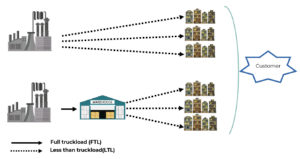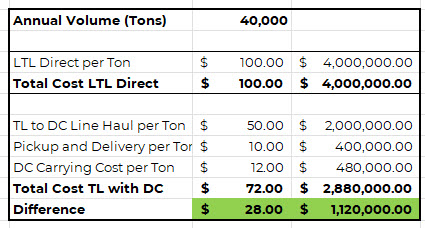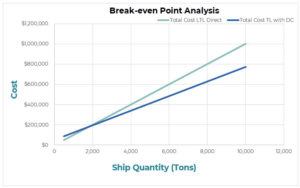Logistics costs account for a significant percentage of the final product cost, depending on where products are sourced, their value and the shipping methods. Warehousing can help optimize the logistics process by defining the best number of warehouses and locations. A key objective of warehousing is to add value to the supply chain. Adding value can include reducing total costs compared to transportation without warehousing, reducing delivery lead times to customers, improving delivery reliability or providing other value-added services.
How Can Warehouses Add Value?
Here I have compared 2 different scenario examples to evaluate how warehouses can add value.
In the initial scenario, the orders are shipped directly to customers (e.g., retailers) using separate LTL (less than truckload) shipments. In the second scenario, the shipments are combined into a single TL (truck load) shipment to a distribution center (DC) in the same area of the customers. The DC splits the loads into local deliveries, called break-bulk, i.e., dividing truckloads, railcars or containers of homogeneous items into smaller crates, bags, boxes, drums and barrels for shipping to the customer.
If the cost of the transportation and warehousing services involved in the second scenario is less than the cost in the first scenario, then the DC is adding value. DCs also provide many similar value-added services, such as the consolidation of LTLs from various suppliers into TLs prior to shipping.
Let’s look at an example in which the cost of each scenario is calculated, and the least-cost method is chosen. Assume that the annual shipping volume is 40,000 tons, the cost of LTL direct to customers is $100 per ton, the cost of TL shipments to the DC is $50 per ton, the pickup and delivery cost is $10 per ton and the DC’s inventory carrying cost is $12 per ton. Figure 1.2 shows the results of these calculations.
In this analysis, the DC with the full truckload line haul saves $28 dollars per ton or $1.1 million at 40,000 tons. In this scenario, it is beneficial to use the DC to ship to the customer. Note that if the cost associated with the DC is more expensive, then it’s advantageous to ship directly.
Note also that this analysis can include fixed costs associated with the DCs. In such cases, the break-even analysis is helpful to decide if, above a particular shipping volume, it will be preferred to use a DC, below the break-even point it is better to ship directly. As you can see in figures (1.3, 1.4), if the annual shipping unit is less than 1,500 tons, then it is economical to ship directly, and if the shipping unit is greater than 1,500 tons, then ship using the DC.
Conclusion
To conclude, in the era where information is widely available, it is highly important to create a value proposition and transfer it to our end consumers. Therefore, it is recommended to reconfigure the supply chain process and enhance the optimized warehousing process through break-even analysis to understand the most appropriate logistical process.









